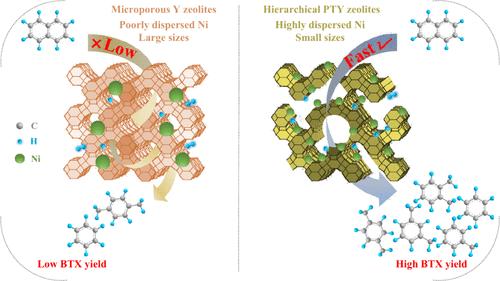萘选择性加氢裂化制BTX分级Ni/Y催化剂的孔结构工程
IF 7.3
1区 化学
Q1 CHEMISTRY, MULTIDISCIPLINARY
引用次数: 0
摘要
双功能催化剂催化萘选择性加氢裂化是将多环芳烃转化为高值BTX的有效途径。实现高加氢裂化活性和BTX产率的关键是设计具有适度加氢和开环裂化能力的双功能催化剂,这取决于适当的酸性质和织构性质以及适当的金属-载体相互作用。本文通过Y分子筛的孔结构工程和乙二胺辅助浸渍策略,设计了具有开放的分级孔结构、中等酸度和高度分散的小颗粒Ni的分级Ni/PTY(后处理Y)催化剂。Ni/PTY催化剂开放的分级孔结构和可调的酸度优化了金属-酸位之间的平衡,有利于加氢、异构化和裂化途径的选择性。结果表明,优化后的Ni/PTY催化剂具有较高的转换频率值(TOF, 14.5 h-1)和反应速率常数(kHCK, 2.8 h-1),萘转化率为88.7%,BTX收率为62.5%。进一步提出并研究了Ni/PTY催化剂体系可能的反应途径和反应机理。本文章由计算机程序翻译,如有差异,请以英文原文为准。

Pore-Structure Engineering of Hierarchical Ni/Y Catalysts for the Enhanced Selective Hydrocracking of Naphthalene to BTX
Selective hydrocracking of naphthalene over bifunctional catalysts is promising for the upgrading of polycyclic aromatic hydrocarbons into high-value BTX. The key to achieving high hydrocracking activity and BTX yield is to design bifunctional catalysts with moderate hydrogenation and ring-opening cracking capability, which relies on appropriate acid and textural properties as well as suitable metal–support interactions. Herein, we designed hierarchical Ni/PTY (post-treatment Y) catalysts with open hierarchical pore structure, moderate acidity and highly dispersed small-sized Ni species via the pore-structure engineering of Y zeolites and the ethylenediamine-assisted impregnation strategy. The open hierarchical pore structure and tunable acidity of Ni/PTY catalysts optimized the balance between metal–acid sites, which was beneficial to the selectivity of the hydrogenation route, isomerization route and cracking route. As a result, the optimized Ni/PTY catalysts showed a superior naphthalene conversion of 88.7% and BTX yield of 62.5% with high turnover frequency values (TOF, 14.5 h–1) and reaction rate constants (kHCK, 2.8 h–1). Furthermore, the possible reaction pathway and mechanism was proposed and studied for such Ni/PTY catalyst system.
求助全文
通过发布文献求助,成功后即可免费获取论文全文。
去求助
来源期刊

ACS Sustainable Chemistry & Engineering
CHEMISTRY, MULTIDISCIPLINARY-ENGINEERING, CHEMICAL
CiteScore
13.80
自引率
4.80%
发文量
1470
审稿时长
1.7 months
期刊介绍:
ACS Sustainable Chemistry & Engineering is a prestigious weekly peer-reviewed scientific journal published by the American Chemical Society. Dedicated to advancing the principles of green chemistry and green engineering, it covers a wide array of research topics including green chemistry, green engineering, biomass, alternative energy, and life cycle assessment.
The journal welcomes submissions in various formats, including Letters, Articles, Features, and Perspectives (Reviews), that address the challenges of sustainability in the chemical enterprise and contribute to the advancement of sustainable practices. Join us in shaping the future of sustainable chemistry and engineering.
 求助内容:
求助内容: 应助结果提醒方式:
应助结果提醒方式:


